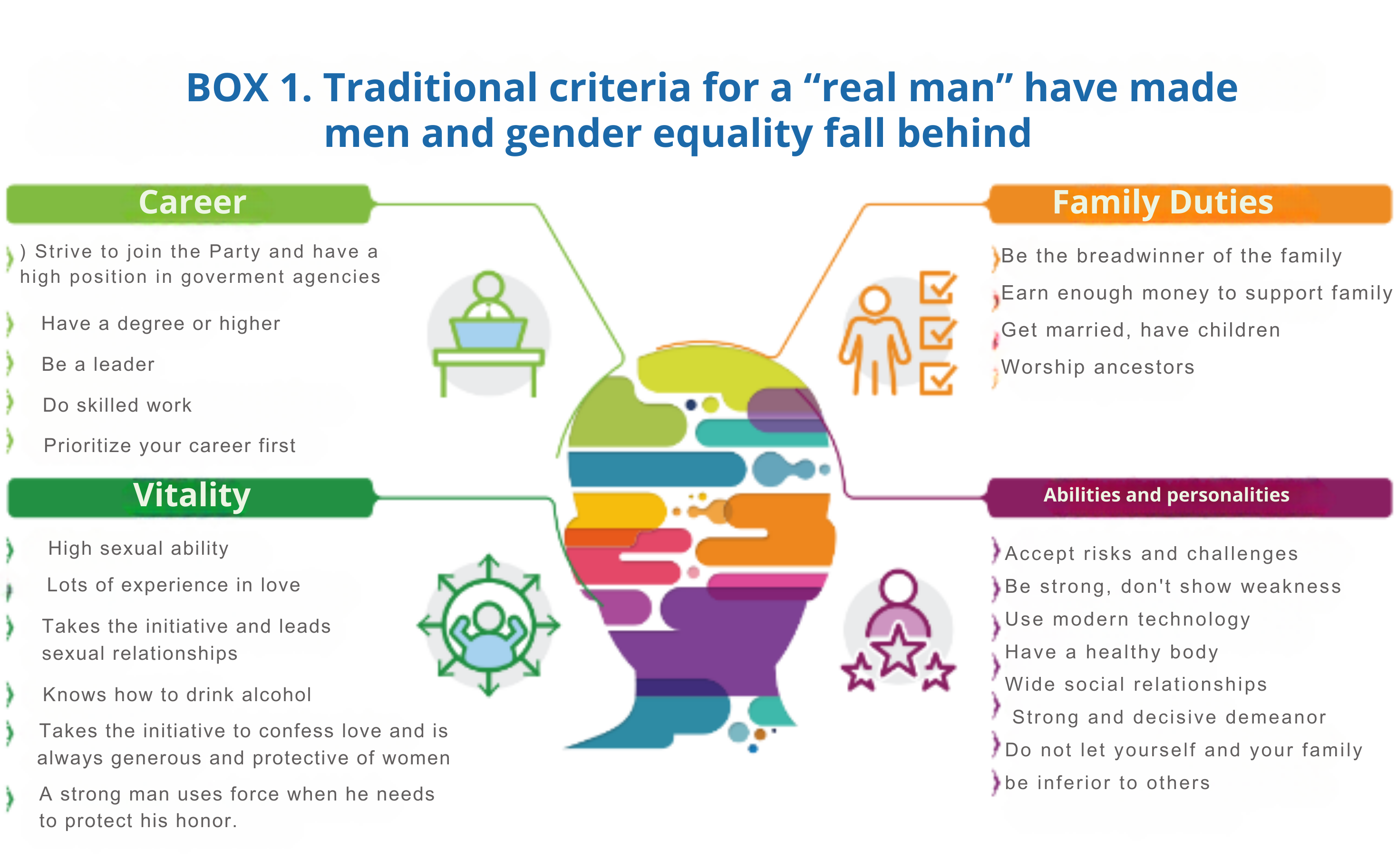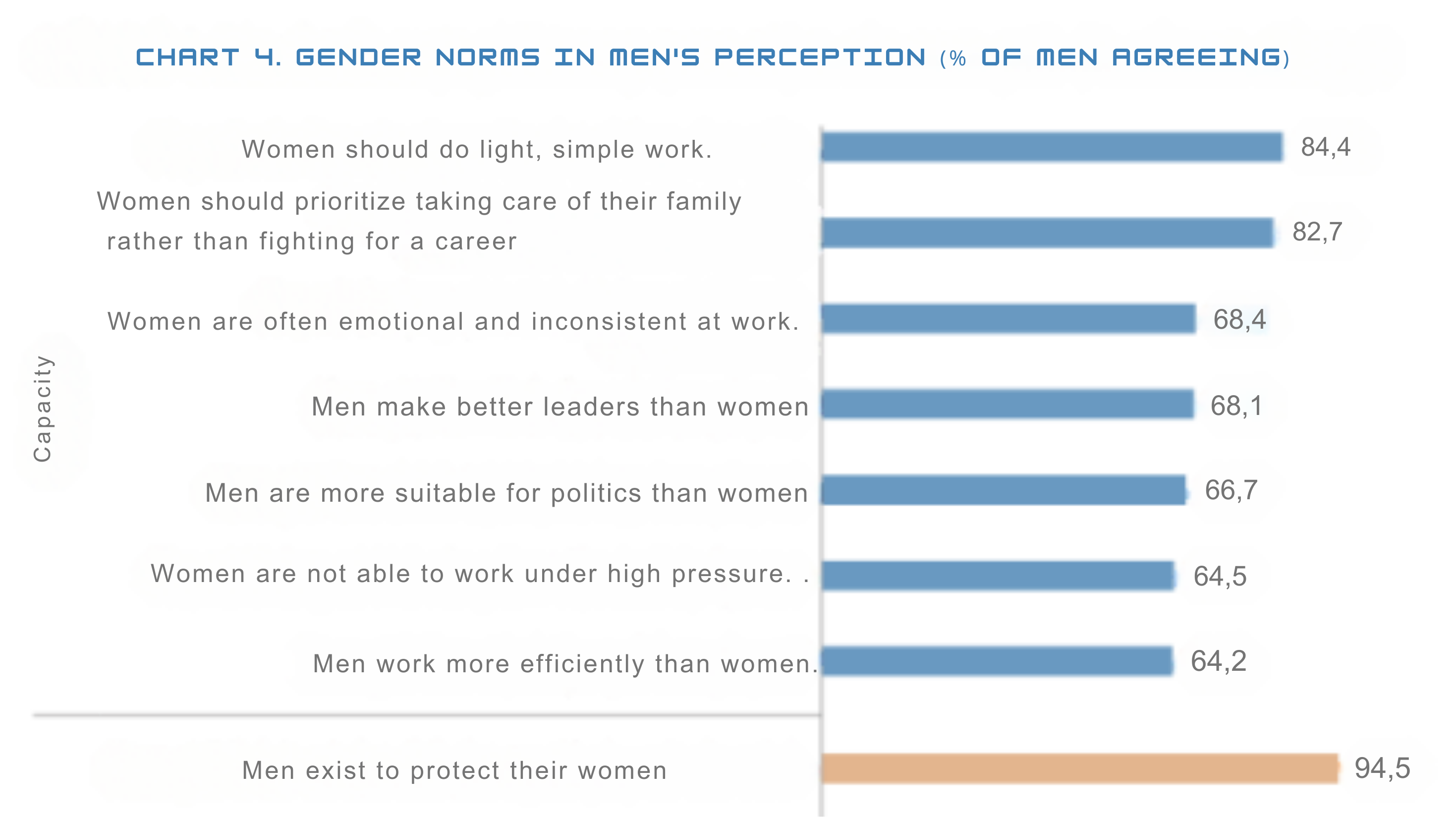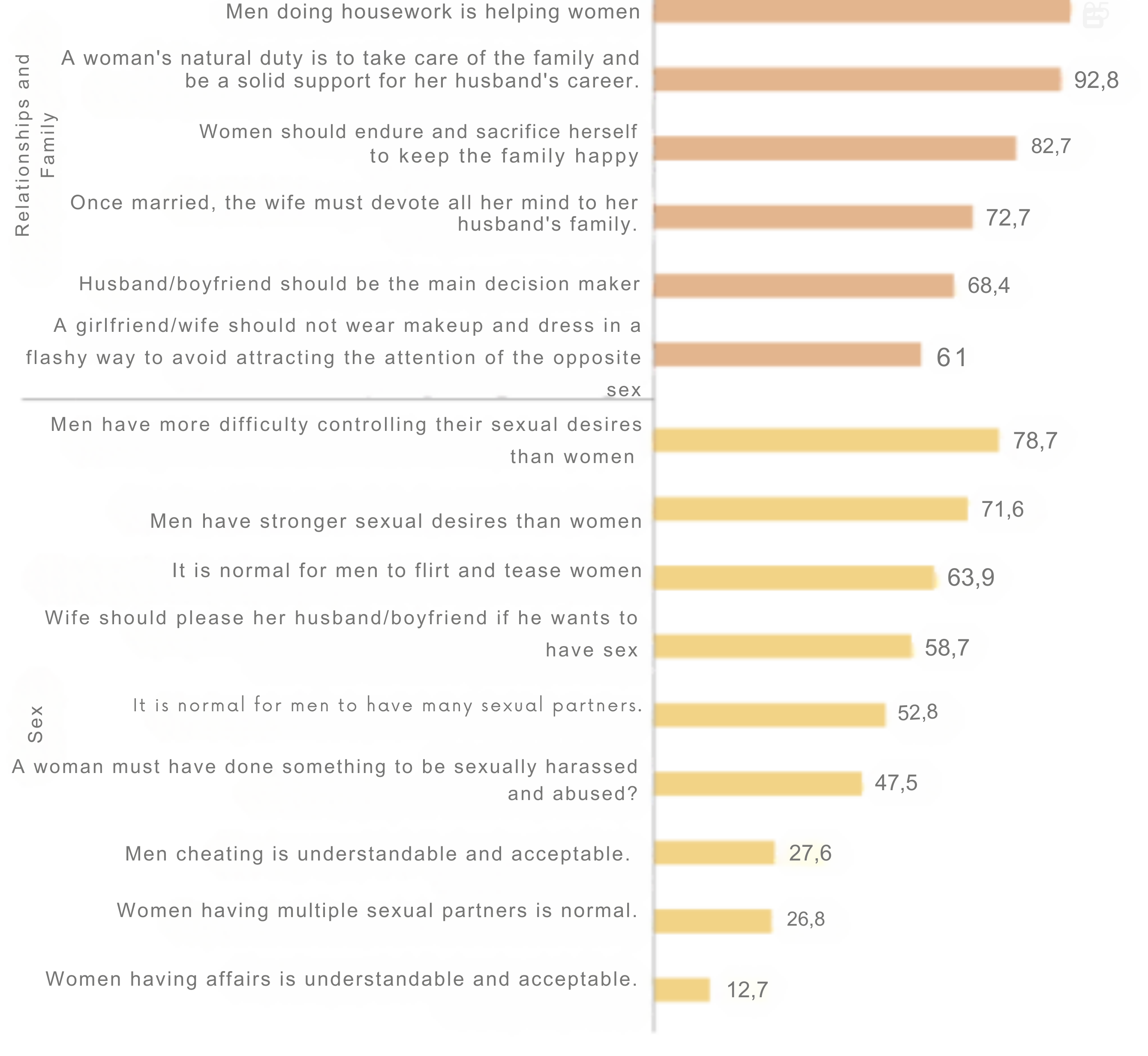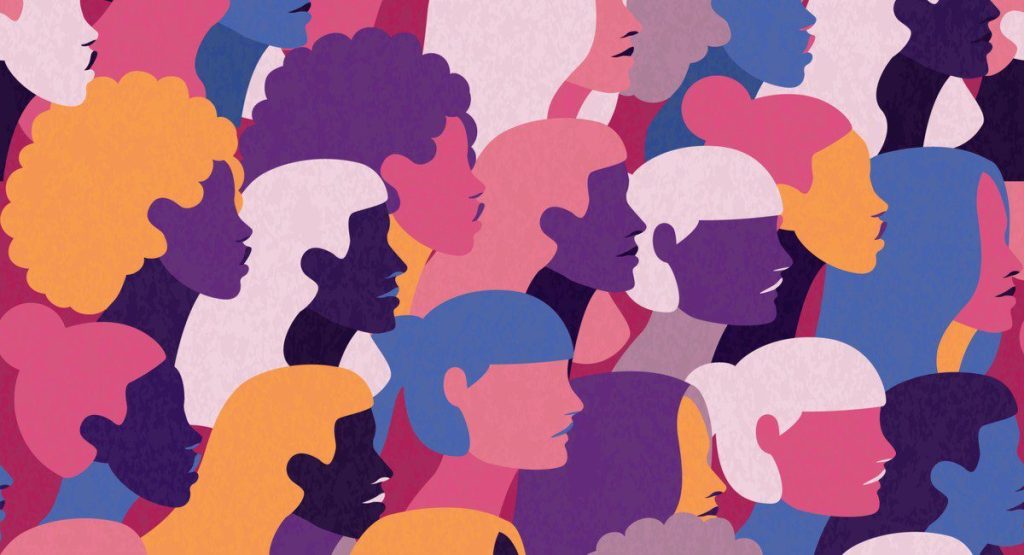Decao was violent towards Lam Minh, so he “physically interacted” with her. Please read about Decao in part 2.4.4 Domestic violence. Image source: afamily.vn
The inspiration to write this article is thanks to a hate comment whose author didn’t know how to write capitalized words in the article “The Crisis of Femininity – How to be considered a “real” woman in today’s era?”.
(Translation: – when you talk about a crisis, you only focus on the crisis women face, even though everyone experiences crises. Society has always had stereotypes about each person’s role, and struggling with these stereotypes is common. So why do you only target women in such a broad issue?, is it because you want to claim victimhood, or because you refuse to acknowledge the crisis faced by the other gender?)
My response was: “Because I am a woman. Who would believe me if I wrote about men?” But then I thought more: Erik Erikson was a man that wrote about women and did so correctly. He was, however, a famous psychologist, whereas I am not. Yet, as Mr. Tornad mentioned in his article, we should value opinions more than authority. That inspired me to write this article, offering men a perspective on how women perceive masculinity.
In summary, this article argues that while women face certain stereotypes of femininity, such as being expected to bear children and maintain a family, men lack a healthy stereotype of masculinity to follow and develop themselves.
This article primarily references the research paper “Men and Masculinities in an Integrated Vietnam – Key Findings and Implications for Gender Equality” by the Institute for Social Development Studies (ISDS).

An extremely good report, highly recommended for everyone to read. Photo source: ISDS
1. The Crisis of Masculinity and Its Foundational Concepts
I have already written about the definitions of identity (including identity crisis), gender roles, and gender stereotypes in my previous article on the femininity crisis. Today, I will introduce three additional definitions: gender norms, masculinity, and dominant masculinity.
Source: Jurien Huggins – Unsplash
According to the ISDS study, gender norms “define what masculinity is, what femininity is, and how men and women should behave in everyday life.” [1]
Next, the Institute for Social Development Studies paper defines both masculinity and its dominant form, hegemonic masculinity:
“Masculinity is a specific pattern of social behaviors or practices that are associated with ideas about how men should behave and their place in gender relations […]
Hegemonic masculinity is a type of ‘highest-valued’ and idealized masculinity that justifies men’s dominance over women in general and allows some men to stand above others.”
Understanding masculinity also requires discussing patriarchy, as the two concepts are deeply intertwined. The ISDS paper states: “Societies where people are ranked according to their status are called caste-like societies. The placing of greater value and status on men and boys than on women and girls is a result of gender-based class distinctions. This gender-based class distinction is called patriarchy.”
The relationship between “hegemony” and “patriarchy” is further explained by Gender&LitUtopiaDystopia as follows: “In terms of gender, hegemony is used to describe patriarchal dominance, the control that men have and have had over women and society.” [2]
2. 5 important findings from the ISDS Men’s Study
According to the research paper titled “Men and Masculinities in an Integrated Vietnam,” male identity is socially shaped through a complex process of cultural interaction, in which men learn gender scripts appropriate to their culture and adapt those scripts to make them socially acceptable. Consequently, the experience of masculinity varies and is neither uniform nor universal for all men in society.
Building on this framework, the research highlights 5 important findings, which I will analyze in more details in the article.
2.1 Finding 1: The “real man” stereotype reinforces traditional masculine norms, which have maintained men’s superiority over women.

Source: ISDS
The majority of respondents, regardless of age, background, and location, emphasized the core value of a real man, which is the role of “family duty”, specifically the two most important criteria: being the breadwinner of the family and providing financial support for a wife and children.
Photo credit: @Breakbadquotes -X
This is why many men are obsessed with money, because only with money can they take care of their families. That leads to a debate about choosing love or choosing a career. Most young men will choose a career. Because with a career comes money, and then other good things will come, that’s what they think.
Image source: .sinhvientphcm.com
However, “the quantitative analysis of this study shows that there are variations in the concept of real men among different groups of men. Young men, men living in urban areas, men with higher education, and men who are more involved in globalization seem to have fewer concepts and practices related to traditional, rigid masculine norms. An example that illustrates this modern perspective is the story of Dr. Chi Nguyen – known as The Present Writer – and her husband, Joe Vu. While it is often said, ‘Behind every successful man, there is a supportive woman,’ Joe chose to ‘step back’ and allow Dr. Chi to focus on her career. In an excerpt from the article What My Husband Taught Me About Gender Equality, Dr. Chi wrote: ‘My husband used to be a restaurant owner, then because he wanted to start a family with me, he left his business to go to a new city to work for hire. When I had a young child but wanted to go to work, my husband volunteered to stay home and be a full-time father […] Every time I said, “Thank you so much!” for doing the housework, my husband would reply, “You don’t have to say thank you. This is my job!“‘ [3]. Reading the entire article, her followers also saw a fresh and modern way of thinking from Joe – a Vietnamese American.
Image source: Website The Present Writer
2.2 Finding 2: Traditional masculine norms negatively impact men.
In this finding, ISDS stated that: “Many masculine norms place excessive expectations and restraints on men and those around them. Further analysis of the study findings showed that the more traditional masculine norms a man has, the more he is likely to engage in controlling/violent behavior towards his wife/partner.” Therefore, having a well-paid job has become an important symbol of masculinity.
Indeed, finances and career were found to be the two biggest stressors for men in both rural and urban areas. Nearly a quarter of the men surveyed admitted that they felt pressure in their lives, with more than 80% expressing concerns about their finances, and nearly 70% feeling stressed about their careers. Pressure on men tended to decrease with age but increased with education level and with working time.
Image created by Freepik.
These pressures can have a detrimental impact on men’s mental health, especially among young men and men living in urban areas, who are more likely to report negative emotions in the 12 months leading up to the survey.
In his book The Meaning of Madness, Dr. Neel Burton states, “Women are twice as likely to suffer from depression as men” [4]. However, compared to women, men are three times more likely to commit suicide in Australia, 3.5 times more likely in the US, and four times more likely in Russia and Argentina [5]. An important characteristic of men, shaped by society, is that they are conditioned not to be ‘feminine,’ not gossipy, not complaining, and not ‘weak.’ As a result, men often bottle up their pain and find it difficult to express their emotions. Dr. Burton also said, ‘Men often cope with difficulties through self-centeredness, anger, or alcohol and drug abuse’ [6]. These pressures are not only placed on themselves but also on women, as the next finding shows.
2.3 Finding 3: Men still hold many gender-biased norms that hinder women’s empowerment and justify gender-based discrimination.
Biased gender norms are still very common in men’s thinking about men and women. The figure below shows common gender norms in men’s perception.


We can see that these gender norms have a strong influence on gender roles. Women mainly play production and reproductive roles, which are not as important as production and community roles like men. Even the two thoughts “Men are better leaders than women” and “Men are more suitable for politics than women” can be seen as global issues after Hillary Clinton’s defeat in the 2016 US presidential election, where she was a strong competitor to Donald Trump.
The ISDS report also pointed out that men “talk about women first as good housewives, taking care of the family, then loving their husband and children, and then doing social work”. Regarding this, a 43-year-old man in Hanoi shared his opinion: “A good wife must first be a good housewife, then love her husband and children, and then have a good job.” That is, the reproductive role – which is less socially recognized than the productive role – is often assumed to be the woman’s responsibility. Neglecting the productive role, not only exacerbates gender inequality but also places additional pressure on men to earn a lot of money.
2.4 Finding 4: Urban millennial males are agents of “positive deviance.”
One encouraging finding from the study is that “younger men from urban areas, who are well-educated and more globalized, tend to be less influenced by traditional and rigid masculine stereotypes, along with gendered norms toward women. Attitudes among urban millennial men toward masculinity, marriage, family, women, and gender equality are evolving positively […] These are signs of positive deviations from the traditional gender division of labor.”
2.4.1 Division of labor in the household
In today’s family life, daily housework such as cooking, doing laundry, and other household chores is predominantly done by women, with 61.5% responsible for cooking, 62.3% for laundry, and 57.6% for cleaning. In contrast, husbands are primarily responsible for external affairs, such as representing the family in interactions with the government and the community (69.5%) and participating in extended family activities (65%).
2.4.2 Decision making in the family
“In general, the husband has the final say in major household expenditures and investments, while the wife makes the final decision on daily expenses.
However, young people aged 18-29 are more likely to make decisions with their wives than men in older age groups. The proportion of both spouses making decisions is also higher in urban areas than in rural areas. For example, for major expenditures and investments, 53.7% of men aged 18-29 in urban areas make decisions with their wives, compared to 37% of young people in rural areas. Similarly, for daily household expenditures, 34.3% of men aged 18-29 in urban areas make decisions with their wives, compared to 22.8% in rural areas.”
2.4.3 Property ownership
“The proportion of men owning valuable family assets is significantly higher than that of women. The association between “money” and “power” is evident. Specifically, the proportion of husbands who are the sole owners of real estate is nearly seven times greater than that of wives (28.2% compared to 4.5%). Likewise, the proportion of husbands who own large assets such as cars, means of production, businesses, and other valuable property is significantly higher than that of wives who are the sole owners […] Qualitative research results further indicate that the practice of only men owning valuable family assets remains common. However, younger men are showing a tendency to be more willing to share ownership of these assets with their wives.”
2.4.4 Domestic violence – Promoting (Decao) patriarchy
“In general, men are more likely to physically or verbally abuse their wives/partners than women are to abuse their husbands/partners. For instance, the rate of husbands who have physically abused their wives is 8.1%, more than double the rate of wives who have abused their husbands (3.9%)”. This behavior stems from a mindset that justifies the use of force to protect one’s perceived authority or self-image. Many men feel the need to assert their dominance through violence when they believe their authority is challenged.
The patriarchal ideology deeply ingrained in Vietnamese men’s mindset is considered one of the main causes of domestic violence. A man who sees himself as the head of the family often believes he has the right to discipline and control his wife and children.
One recent example involves Decao, a notorious figure, who reportedly physically interacted with his wife Lam Minh over trivial matters, such as food arrangements on the dining table. In one instance, his mother initiated physical violence, and Lam Minh refused to endure it passively. However, instead of addressing the root of the issue – his patriarchal mindset – Decao framed the situation as a media crisis. He dealt with the press but did not take responsibility or offer an apology to Lam Minh. In his statement, he used euphemistic language to describe the altercation, saying: “My mother interacted with my wife, and my wife interacted back, then I lost my temper and increased the interaction.”
This incident has sparked public discussions and increased awareness about patriarchy and domestic violence, encouraging society to be less silent and more proactive in addressing such issues. Hopefully, Decao will learn to manage his anger and avoid resorting to “interactions” in the future.
The image with the caption: “Saying a lot on the 1st! Do you want to get punched?” by Chau Bui was dug up again, making netizens surprised: It turns out Decao wasn’t acting. Image source: Chau Bui’s IG.
Still, it’s a good sign that a group of “positively deviant” men are looking for freer ways to express their masculinity without being bound by rigid norms.
2.5 Finding 5: The COVID-19 pandemic has diverse impacts on masculinity and gender equality.
Although it has been four years since the COVID-19 pandemic, it would be remiss not to mention its enormous impact on both men and women in particular and on gender equality in general. However, I will summarize them as follows: Controlling behavior, financial abuse, as well as psychological, physical, and sexual domestic violence, have occurred more frequently, by at least 70% compared to the pre-outbreak period. The occurrence of domestic violence is mainly due to the indirect negative impacts on the economic situation of households and the measures to prevent the pandemic.
3. Signs of male crisis:
Despite being different in stereotypes—women being confined to a ‘childbearing’ mold and men being trapped in an outdated ‘patriarchal’ mold—there is little distinction in the existential crises experienced by both genders. According to lukincenter.com, the common signs of an existential crisis include:
- Questioning your fundamental understanding of yourself.
- Feeling anxious, restless, or dissatisfied with life.
- Altering your sense of self-worth to fit any environment, situation, or relationship.
- Struggling to answer questions about yourself.
- Lacking trust in your ability to make the right decisions. [7]
Clinical psychotherapist Nathaniel Oke explains: “Men feel less powerful and hopeful than they once did […] The crisis emerges when men begin to question the meaning of life. They fear failing to meet their own expectations and are heavily influenced by societal prejudices about masculinity and what it means to be a man.” [8] These notions, as discussed in section 2.1 of this article, are tied to the ‘real man’ archetype that perpetuates traditional norms and pressures.
The question remains: what is the solution?
4. How to solve the male crisis:
The key to addressing this issue lies in taking the time to explore and understand yourself while identifying your core values:
- Acknowledge and accept your feelings.
- Explore your beliefs and interests.
- Learn about different identities and engage with diverse people.
- Reevaluate your goals.
- Consider how cultural and family norms influence your choices.
- Seek support from family, friends, partners, and mental health professionals when necessary.
Sandy, a British man, shared: “I think all men are trying to find and create something for themselves. But I’m not sure if it’s something we truly want to do, or if it’s something we feel compelled to do in order to be accepted by our friends and family.”
Clinical psychotherapist Hilda Burke adds: “Young men often set specific milestones for ages 18, 21, and 30, assuming they must be achieved. It’s important to pay attention to these milestones.” Burke advises: “When we feel obligated to reach certain goals by a certain age, that’s when anxiety begins to creep in.” [9]
5. Conclusion
Being masculine in the way that both society and we expect can be a lifelong struggle. However, when it comes to dealing with existential crises, I believe that, while we don’t need to “embrace” the struggle in the way some idealize, we shouldn’t romanticize the pain either. Instead, we should face it with honesty. Imagine the kind of man you want to become, then critically evaluate the opinions society offers—decide which ones are worth considering and which ones should be disregarded. Identifying the right problem leads to the right solution. Otherwise, as the Cheshire Cat wisely said, “If you don’t know where you’re going, any road will get you there!”
REFERENCES
[1] ISDS_Men Report_Summary_VN.pdf. “ISDS_Men Report_Summary_VN.pdf.” Google Docs, 2019, drive.google.com/file/d/1nArVuT6pagVlvHXdHMKM2EUOfQctoUuJ/view. Accessed 1 June 2024.
[2] Contributors. “Definition of Hegemony.” Gender&LitUtopiaDystopia Wiki, Fandom, Inc., 2024, genderlitutopiadystopia.fandom.com/wiki/Definition_of_Hegemony#:~:text=In%20terms%20of%20gender%2C%20hegemony,had%20over%20women%20and%20society. Accessed 10 May 2024.
[3] Nguyễn, Chi. “Chồng Tôi Dạy Tôi Điều Gì về Bình Đẳng Giới? – the Present Writer.” The Present Writer, 20 Oct. 2020, thepresentwriter.com/chong-toi-binh-dang-gioi/. Accessed 1 June 2024.
[4] Burton, Neel. The Meaning of Madness. Oxford, Acheron Press, 2015.
[5] Schumacher, Helene. “Why More Men than Women Die by Suicide.” Bbc.com, BBC, 18 Mar. 2019, www.bbc.com/future/article/20190313-why-more-men-kill-themselves-than-women. Accessed 18 May 2024.
[6] Burton, Neel. The Meaning of Madness. Oxford, Acheron Press, 2015.
[7] Konstantin, Dr. “Lukin Center.” Lukin Center for Psychotherapy, 23 June 2022, www.lukincenter.com/5-signs-youre-having-an-identity-crisis/. Accessed 1 June 2024.
[8] News, VietNamNet. “Nam Giới Chịu Khủng Hoảng Tinh Thần Trầm Trọng.” VietNamNet News, Vietnamnet.vn, 2021, vietnamnet.vn/nam-gioi-chiu-khung-hoang-tinh-than-tram-trong-702624.html. Accessed 1 June 2024.
[9] News, VietNamNet. “Nam Giới Chịu Khủng Hoảng Tinh Thần Trầm Trọng.” VietNamNet News, Vietnamnet.vn, 2021, vietnamnet.vn/nam-gioi-chiu-khung-hoang-tinh-than-tram-trong-702624.html. Accessed 1 June 2024.
